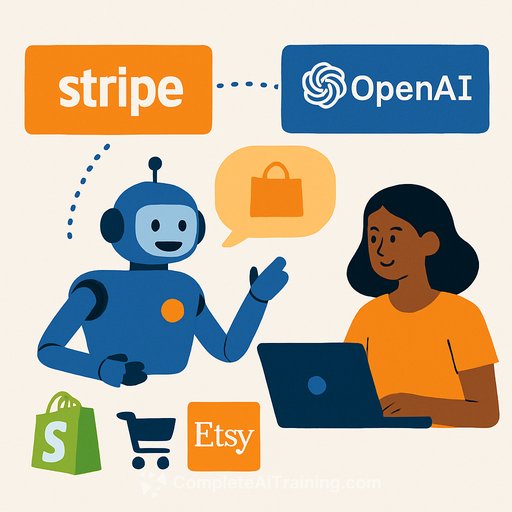Stripe and OpenAI bring agentic AI shopping to chat: what sales teams need to do now
Stripe and OpenAI are rolling out an agentic commerce protocol that lets buyers move from chat to checkout in a few taps. The first visible piece is Instant Checkout inside ChatGPT, with Etsy items and Shopify's million-plus merchants coming online soon. Google announced a competing protocol two weeks earlier, signaling a race to own the infrastructure for AI-driven shopping.
For sales leaders, this means digital agents will source, filter, and buy on behalf of customers-within preapproved budgets and preferences. Your catalog, pricing, and checkout must be ready for machines to act as your new top-of-funnel, mid-funnel, and conversion channel.
What's new
- Stripe's Agentic Commerce Protocol (ACP) provides an open standard to sell via AI agents while keeping your existing payments, systems, and customer relationships. You don't need to process with Stripe to adopt ACP.
- OpenAI's Instant Checkout moves users from chat to purchase quickly; merchants pay a small fee per completed purchase via ChatGPT. Fee details are not yet public.
- Product search results in ChatGPT are organic and unsponsored, ranked by relevance. Items purchasable via the protocol are not boosted.
- Security: Stripe issues a shared payment token scoped to a specific merchant and cart total so agents can initiate payment without exposing buyer credentials. The agent passes the token to the merchant via API to complete the order.
- Broader ecosystem: Stripe is testing with Anthropic, Microsoft Copilot, and Perplexity. Etsy expects agentic shopping to help unique inventory stand out; Adobe reported a 4,700% YoY jump in traffic from AI chats to retail sites.
Why sales should care
Agent-led purchasing is set to grow fast. Edgar Dunn & Co. projects AI-driven commerce to scale from $136B this year to $1.7T by 2030. PayPal's CEO Alex Chriss expects AI agents to drive ~25% of online sales by 2030. The teams that prepare product data, policies, and funnels for machine buyers will capture disproportionate share.
How the flow works (simplified)
- User sets constraints in chat (budget, preferences, size, delivery window).
- AI agent selects items and assembles a cart.
- Stripe issues a merchant- and total-scoped token.
- Agent passes token to the merchant via API; merchant completes the charge and fulfillment.
Near-term opportunities for your sales org
- Conversational storefronts: Publish clean, structured product data so agents can interpret variants, sizing, materials, shipping, and availability without ambiguity.
- Merchandising for agents: Standardize titles, attributes, and photography; create bundles that map to common intent (gifts, back-to-school, home office, event-ready).
- Promotion logic: Translate promos into machine-readable rules (eligibility, stacking, expiration) so agents can apply them correctly.
- Attribution and CRM: Tag "agent-originated" sessions, orders, and revenue; pipe chat-intent signals (occasion, urgency) into your CRM for lifecycle campaigns.
- Consent and guardrails: Define budgets, SKU exclusions, and shipping thresholds for agent purchases; set refund/return rules that won't trigger support overload.
- Fraud and policy: Tighten risk checks around tokenized agent orders; align dispute evidence with agent flows (address verification, delivery proof).
- Marketplace strategy: If you sell on Etsy or Shopify, prioritize SKUs likely to be agent-selected (clear utility, high ratings, fast shipping).
- Cross-agent coverage: Plan to support multiple agents so you're not dependent on one platform.
Implementation checklist
- Meet with payments/engineering to review ACP support and your current PSP capabilities.
- Identify 3-5 repeatable chat intents you can win (e.g., "sustainable gift under $50"). Build bundles and landing content for each.
- Audit product data: titles, attributes, variant logic, shipping SLAs, and return policies. Add structured data and fix inconsistencies.
- Enable an API endpoint for agent checkout and confirm token handling, order confirmation, and receipts.
- Update fraud tooling for tokenized carts; run test transactions end-to-end.
- Revise T&C to explicitly cover agent-mediated purchases and permissions.
- Add analytics for agent sessions, conversion, AOV, and repeat purchase behavior.
- Launch a 30-day pilot with limited SKUs and a clear success threshold; iterate weekly.
Metrics to track
- Agent-attributed conversion rate and AOV
- Time-to-checkout from first query
- Opt-in rate for agent purchasing and budget settings
- Share of GMV from agents vs. traditional web/app
- Refund and chargeback rates on agent orders
- Top agent queries and the SKUs they resolve to
- CAC vs. chat channel acquisition costs
Open questions to monitor
- Final fee structure for merchants purchasing via ChatGPT
- How "organic" relevance is computed and how often it updates
- Privacy and data retention around chat intents and order history
- Returns, exchanges, and post-purchase support flows mediated by agents
- Cross-border taxes, duties, and localization for agent checkouts
What to do this week
- Schedule a technical review with your payments lead on ACP compatibility.
- Choose one intent-led use case; create a bundle and a promo the agent can understand.
- Clean up the top 50 SKU records for clarity and completeness.
- Draft agent purchasing guardrails (budgets, excluded SKUs, shipping rules).
- Train your sales and CX teams on conversational commerce scripts and escalation paths.
Helpful resources
Sales advantage will come from clarity: clean product data, clear rules, fast checkout, and tight feedback loops. Get those right, and agents will consistently choose you.
Your membership also unlocks:






